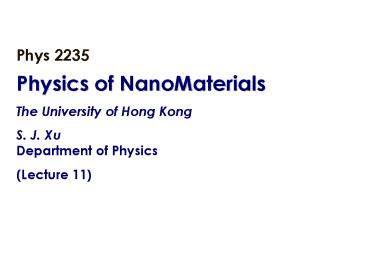NanoVision 2020 - PowerPoint PPT Presentation
1 / 32
Title:
NanoVision 2020
Description:
Growth, Properties and Infrared Photodetectors of InGaAs/GaAs Self ... The tetragonal bonding of a carbon atom with the four nearest silicon neighbours. ... – PowerPoint PPT presentation
Number of Views:68
Avg rating:3.0/5.0
Title: NanoVision 2020
1
Phys 2235 Physics of NanoMaterials The University
of Hong Kong S. J. Xu Department of
Physics (Lecture 11)
2
Research Topics
- Contents of Lecture 11
- Growth, Properties and Infrared Photodetectors of
InGaAs/GaAs Self-Assembled Quantum Dots - Optical Properties of SiC nanocrystalline Film
3
Self-Assembled Growth
Table I Critical thickness and mismatch strain of
quantum dots self-organization growth
4
Relationship between Critical Thickness and
Lattice Mismatch Strain
Modeled by using Suo and Zhangs model
Z. Suo and Z. Zhang, Phys. Rev. B 58, 5116
(1998).
5
Single Layer QDs, Coherent Multi-Layers QDs, and
Non-Coherent Multi-Layers QDs
6
Effect of Postgrowth Annealing
- Rapid thermal annealing was used to modify the
structural and optical properties of the InAs
dots. - Significant narrowing of the peak width (from
78.9meV to 20.5meV) of the emissions occurs
together with about 260meV blue-shift at
annealing temperature up to 850C. - TEM observation shows that quantum dots disappear
due to too high annealing temperature.
QD layer
Reference QW
Xu, et al., APL 72, 3335 (1998).
7
Annealing Effect on Intersubband Energy Spacing
Band filling effect
Wang, et al., JAP 86, 2673 (1999).
8
Measured HRXRD rocking curves of the as-grown and
850 C annealed InAs/GaAs QDs
Annealing temperature dependence of photon
energies of the ground state and the excited
state emissions.
9
Simulation of XRD Rocking Curves of Annealed QDs
Significant In-Ga atom intermixing even in the
as-grown InAs/GaAs dots.!
Xu, et al., APL 77, 2130 (2000).
10
Pressure PL of QDs
- Left figure Room-temperature PL spectra from the
InAs dots under different pressures. - Right figure Pressure dependence and
coefficients of various transitions.
11
PLE Spectra of QDs
- PL and PLE spectra of the InAs QDs at 10 K.
Electronic structures of the InAs/GaAs QDs system
is rather complex.
12
Room temperature infrared absorption of
InGaAs/GaAs dots
- Absorption peak is centered around photon energy
of 130 meV. - Strong polarization dependence on incident
infrared radiation
13
Quantum Dot Infrared Photodetectors
SEM top view of quantum dot infrared
photodetectors
Cross-sectional TEM image of QDs for QDIP device
14
Dark current-voltage characteristic of
InGaAs/GaAs QDIP
- At low temperatures, slow variation of the dark
current with temperature indicates stronger
confinement effect of the electron in Quantum
dots. - At higher temperatures, a exponential growth of
the thermionic emission rate of the electrons
results in rapid increase of the dark current
with temperature.
15
Photoresponse spectra of the QDIPs
- Responsivity at 60 K is bout 5 mA/W for
s-polarized incident light. - Responsivity is about 0.5 mA/W for p-polarized
incident light. - Polarization dependence of the responsivity is in
agreement with that of the infrared absorption.
16
Negative differential phototconductance effect
- A threshold voltage of about 0.6 V exists, which
is in agreement with available theoretical
prediction. - Strong negative differential photoconductance
phenomenon that was not predicted by the theory
is found.
17
Applied electric-field dependence of the
photoresponse spectra
- The maximum responsivity of about 80 mA/W was
measured at 30 K and at 1.46 V. - Blue-shift of the response peak occurs with
increasing applied bias.
Xu, et al., APL 73, 3153 (1998).
18
Summary 1
- A series of QDs were grown with MBE. The critical
thickness at which QDs forms depends inversely on
the mismatch strain in a law of 4/3. - Rapid thermal annealing can be used to strongly
modify structure and optical properties of
self-organized quantum dots. - Strong atom interdiffusion exists even in the
as-grown InAs/GaAs QDs. - Pressure coefficients of QDs is significantly
smaller. - Electronic structures of QD system is rather
complex. - Quantum dot photodetectors were demonstrated.
19
Optical Properties of Silicon Carbide Nanocrystall
ine Films
- Silicon Carbide (SiC) is a family of indirect
wide band gap semiconductors having many unique
properties and device applications. - SiC has been known to have more than 200
prototypes. 3C, 2H, 6H, 4H are commonly seen
structures. - In the study, 3C-SiC nanocrystalline films were
grown on Si substrate with ECR-CVD (electron
cyclotron resonance chemical vapor deposition)
method. - Intense photoluminescence and sensitive
atmospheric pressure dependence were observed.
20
Crystal Structure of 3C-SiC
Si
C
The tetragonal bonding of a carbon atom
with the four nearest silicon neighbours. The
distances a and b are approximately 3.08Å and
1.89Å respectively
21
Structure Characterization of SiC nanocrystalline
films
TEM images of SiC nanocry-stalline films
AFM images of SiC nanocrystalline films
22
Steady-state and time-resolved PL spectra of SiC
nanocrystalline films
Time-resolved PL spectra
Steady-state PL spectra
23
Measured PL spectra of sample C under different
air pressures
24
Measured PL spectra of sample D under different
air pressures
25
Measured PL intensity of sample D against
exposure time of UV laser.
26
Measured PL intensity of sample C against
exposure time of UV laser
27
SiC Nanostructures with different cluster size
Si C H
SiC51_H
SiC111_H
SiC81_H
28
Calculated absorption spectra of SiC nanoclusters
with different sizes
- The spectra show a clear blue shift with
decreasing size of cluster - Size dependent absorption spectrum as evidence
for quantum-size effects.
29
SiC nanoclusters terminated by H, OH or NH2
Si C N O H
SiC81_NH2
SiC81_H
SiC81_OH
30
Absorption spectra of SiC-81 clusters were
calculated. The dangling bonds are saturated by
H, OH, NH2, respectively.
31
Close up of the absorption spectra at lower
energy side
32
Summary 2
- Intense light emission covering whole visible
range was observed in SiC nanocrystalline films. - PL spectra of SiC clusters under different air
pressure were measured. - Absorption spectra of SiC clusters terminated by
H, OH or NH2 were calculated.































